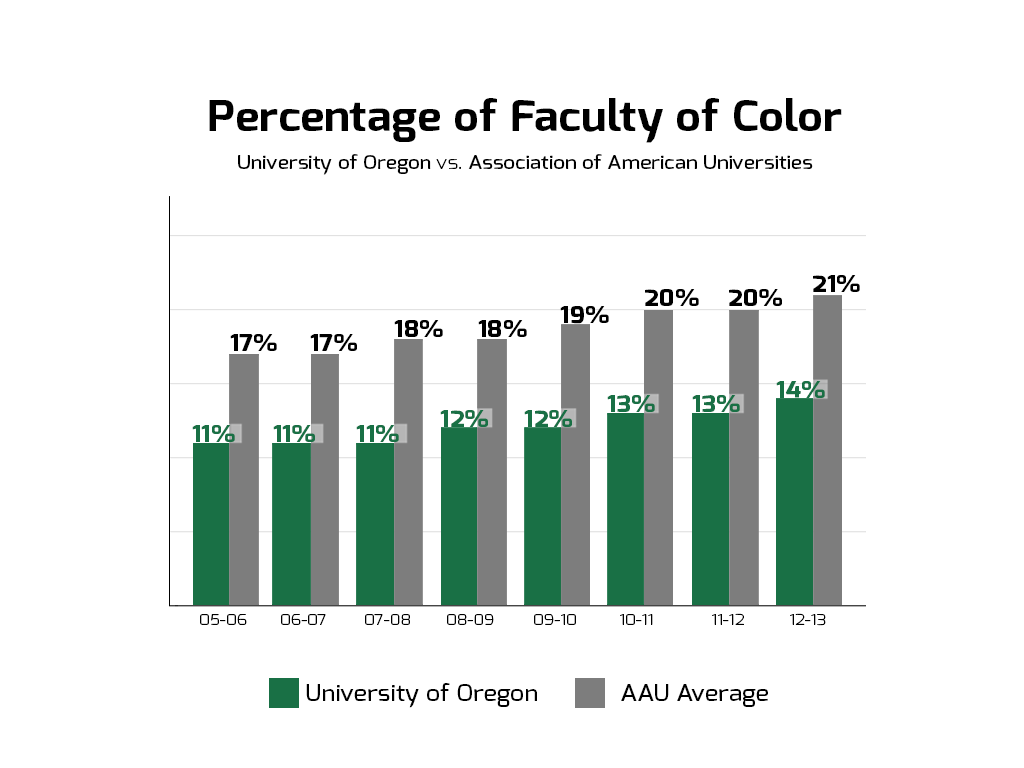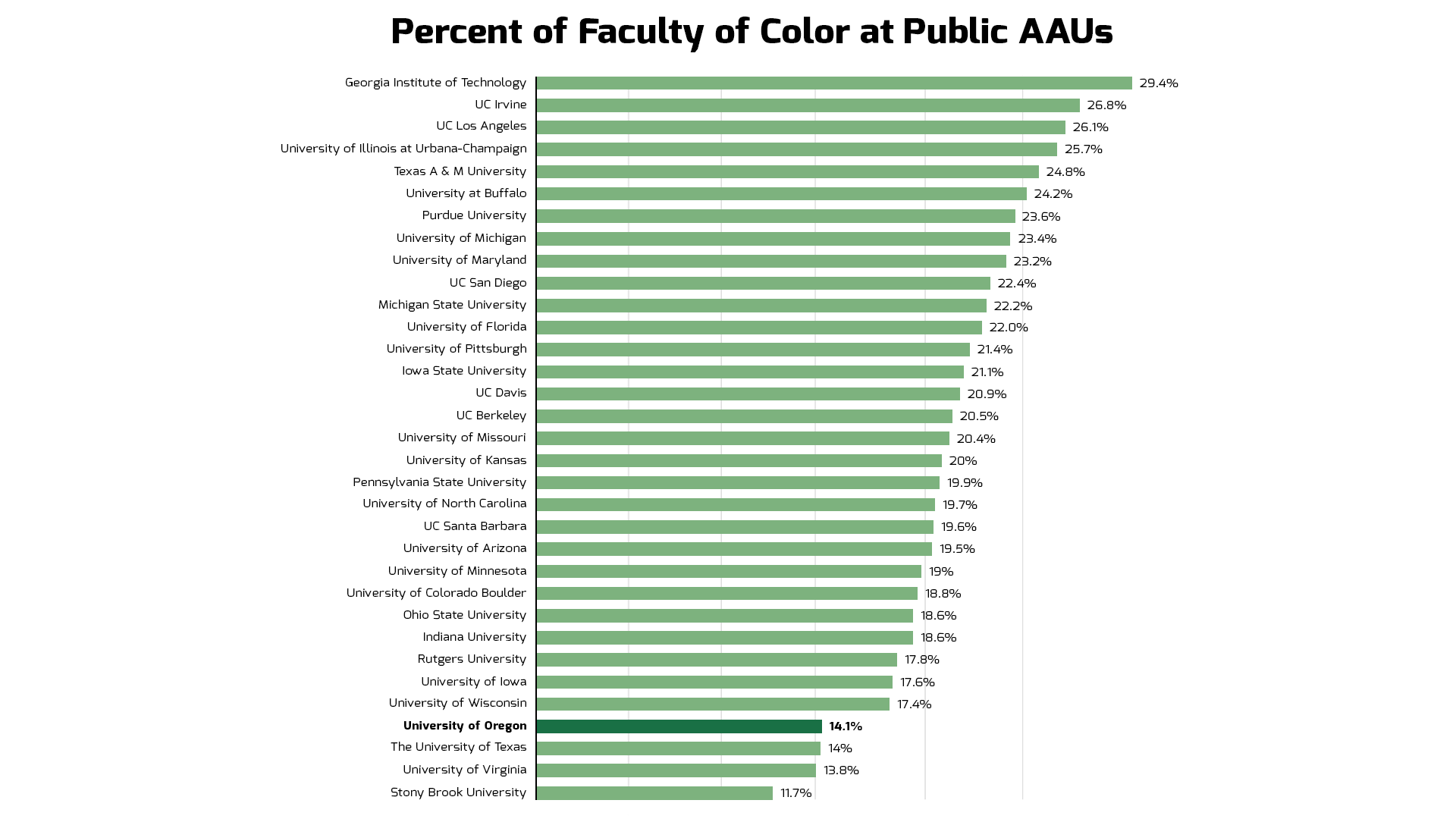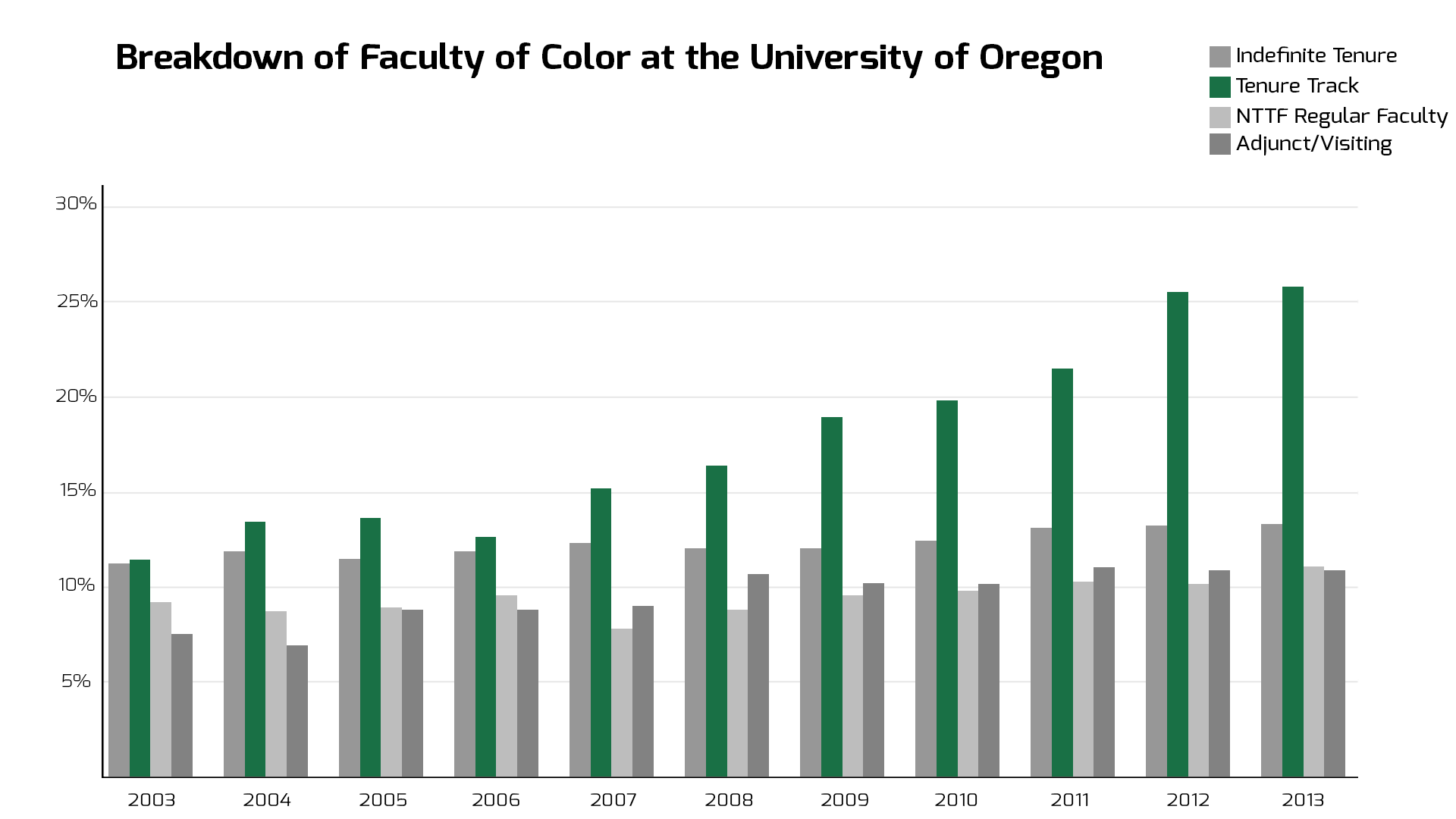

BY SAMANTHA MATSUMOTO & ALEX CREMER
Video by Alyssa Veigel | Header by Kenneth Osborn
When Lamia Karim came to the University of Oregon, she was one of the few South Asian faculty members on campus. The Bangladesh native came to the United States in 1980 and arrived at UO in 2003. As one of the few faculty of color on campus, she felt isolated and marginalized in a dominantly white community. Though Karim had taught at majority white campuses before, she says UO was different because it was less diverse - both on campus and in the wider Eugene area. "It was very lonely," Karim said. "There were very few of us." She found community within a small group of other minority faculty. Today, she is a tenured anthropology professor at the university. Karim was able to build her career at the UO, but her story is an exception.
Lamia Karim Associate Professor & Associate Department Head
Despite an ambitious minority recruiting program, UO struggles to retain faculty of color. Experts say this deprives UO's increasing number of minority students of mentors. It also deprives the general student body of the variety of classes and research that minority faculty bring to a college campus. For the past seven years, the UO has had among the lowest percentages of faculty of color in the nation's top 62 research universities — a group known as the Association of American Universities. Between 2005 and 2012, the UO ranked the lowest among the 34 public schools in the group. Although it moved up the rankings this year to fourth from the bottom, minority faculty at the UO still only represent 14 percent of the total faculty. The AAU average at public schools is 21 percent. Since 2011 the UO has poured over $1 million into recruiting diverse faculty. But the percentage has only shifted 1 point in those three years, and the university has consistently lagged behind the AAU average by 6 to 7 percentage points since 2005.

Ernesto Martinez, a UO ethnic studies professor and co-editor of the book "The Truly Diverse Faculty," says that schools lacking diversity often have unwelcoming environments for professors of color. This can lead to feelings of isolation such as Karim's."Majority white communities are often hostile places," Martinez said. "When you don't see faculty of color like you, it becomes harder to imagine whether people like you should be there at all." Though some argue that less diverse states like Oregon will naturally have less diverse universities, Martinez says that this is irrelevant because faculty are recruited from across the nation. "That just rationalizes places to stay non-diverse," he said. A non-diverse faculty can also hurt students — particularly students of color, Martinez said. The university's proportion of students of color has increased over the years, and 27 percent of this year's freshman class were minority students, the highest in university history. "Students need to be able to visualize themselves," Martinez said. "Part of having a diverse faculty is to provide these students with the tools they need. When you don't see yourself anywhere, it can be a place to say 'peace out.'" The university has struggled for 15 years to increase the diversity of its faculty. In 1999, 75 students and faculty protested in Johnson Hall, demanding increased diversity among faculty on campus. Thirty-one were arrested for refusing to leave the building. After conversations with then-president David Frohnmayer, the students requested a diversity office be created. In 2001, faculty member Joe Wade filed a discrimination lawsuit against the University, which was settled a year later with an agreement that the UO would hire a Vice Provost for Institutional Diversity. (UO administration told the Daily Emerald in 2004 that they intended to create the position before the lawsuit.)
In 2006, the university made national headlines when two prominent faculty members left the university, alleging a racially biased hiring process for the law school dean. The same year, UO created a campus wide diversity plan resolving to increase faculty diversity and to dedicate more money to hiring and retaining faculty of color. At the UO, low salaries make the university less appealing to faculty in general — in 2006, the UO paid 33 percent less than the average AAU institution. Salaries continue to lag behind — today, UO salaries are 13 percent less than the average AAU salary.

Where diversity is concerned, the university has historically lagged behind recruiting a diverse candidate pool through networking at conferences or inviting them to present their research in Eugene. This has put UO at a disadvantage to other universities that emphasize active recruiting. Retaining faculty is another battle. When numbers are already low, it becomes even more difficult to recruit and retain diverse faculty. Daniel Hosang, Director of the Center for Community and Diversity, said less diverse schools like UO often lose minority faculty to schools with larger minority communities. "There's a little chicken and egg to it," Hosang said. "The challenge historically has not only been getting people in the door but getting them to stay." In the past, diverse faculty members have also left the university if they didn't receive tenure. According to Vice President of Equity and Inclusion Yvette Alex-Assensoh, faculty of color often research non-traditional focuses of study, and most tenure positions are evaluated for more traditional fields. Alex-Assensoh thinks that the university needs to consider new ways of evaluating faculty for promotion to make the process more inclusive. "Many of them engage in research at the intersection of disciplines," Alex-Assensoh said. "How do we assess that when it comes time for promotion?"
Yvette Alex-Assensoh Vice President of Equity and Inclusion
Scott Coltrane, former Dean of the College of Arts and Sciences and current Interim President of the university, tried to address the issue by departmentalizing specific disciplines, such as ethnic studies, to help retain faculty of color. This shift gave these departments power to vote on their own faculty tenure cases, which increased retention, according Hosang and other faculty members. The university does not keep records on faculty retention, but university budgets show there's been an increased effort to recruit more diverse faculty. Within Academic Affairs, Vice Provost Doug Blandy has led the charge to actively recruit faculty of color . Last school year, the Office for Academic Affairs awarded $23,786 to travel to conferences and universities with potential candidates and to bring them to campus. As a new program, it hasn't brought new faculty to campus yet, but the campaign helps the UO build its pool of future faculty members, Blandy said. He anticipates that a similar amount will be awarded this year. "We're very optimistic about what the effects will be," Blandy said. "It's been successful in permitting departments to cultivate possible hires and communicating that the UO is committed to diversifying." The UO has also dedicated a sizeable sum — that $1 million — within the past three years to its Underrepresented Minority Recruitment Fund, which gives money to departments that make minority hires. The funds are meant for developing programs to retain faculty of color. Even with these efforts, the UO's overall percentage of faculty of color has only grown by 3 percentage points in the last nine years — from 11 percent in the 2005-2006 school year to 14 percent in 2013-2014. However, more of UO's tenure track faculty is diverse — over 25 percent of 2014 faculty represent minorities, compared to 11 percent in the 2005-2006 school year. Blandy says he expects this progress to continue as more tenure-track faculty are hired over the next five years.

"I think you can see the effects," Blandy said. "We're not where we need to be, but we are on the right trajectory. We need to be continually engaged with actively recruiting a diverse faculty." Across campus, the sentiment is the same: there is still work to be done. This fall, Coltrane announced the UO's plan to hire 150 new faculty members over the next five years. He plans to lay out a new campus wide diversity plan later this year. Alex-Assensoh thinks the school is moving in the right direction, but that it needs to set specific goals. "'What do we aspire to be?' It's an ideal time to ask that question," she said. "It's not enough to say we want to have a more diverse faculty. That is why it is exciting that the president is laying out a specific diversity plan." Karim agrees. "It has improved," Karim said. "It can improve a lot more."
@DavidBaggs: Design | @Sierra_morgann: Web Development | Sasha Gregg: Team Director